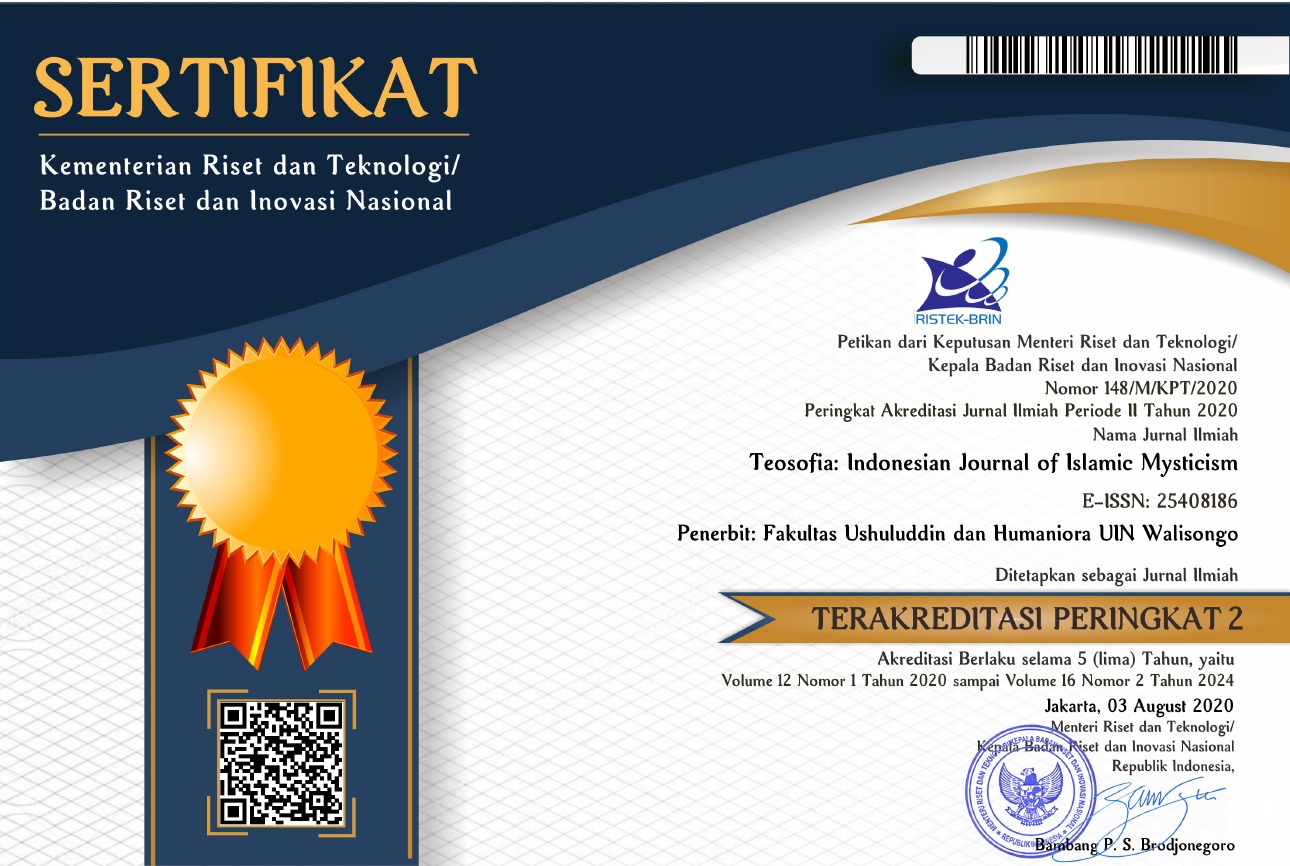Between Legalism and Mystical Intuism: Sunan Kalijaga’s Qibla Direction in Pati and Demak Grand Mosque
DOI:
https://doi.org/10.21580/tos.v12i1.6879Keywords:
Sunan Kalijaga, Historical Mosque, Qibla direction, socio-cultural, mystical kejawenAbstract
This study aims to discover the process of determining the direction of the qibla by Sunan Kalijaga (one of Walisongo), employing a mystical and intuition (divine inspiration) method. This study is a qualitative field research using a socio-cultural approach. The research objects are the Baiturrahim Gambiran Pati Mosque and Demak Grand Mosque, Central Java. These mosques were built by Sunan Kalijaga. The results of this study revealed why the people of Gambiran Pati and Demak Grand Mosque still use the Sunan Kaljaga version of the qibla direction compared to the qibla direction using scientific technology. Some factors that influence include, first, the historical value factor of the Baiturrahim Mosque and Demak Grand Mosque as the guardian mosque and also the legendary figure of Sunan Kalijaga. Second, The socio-cultural characteristics of the Gambiran Pati and Demak communities are familiar with the mystical Kejawen.
Contribution: This research contributes to understanding the method of determining the direction of the qibla by Sunan Kalijaga using mystical and intuitive approaches. It focuses on two historical mosques, the Baiturrahim Mosque in Gambiran Pati and the Grand Mosque of Demak, considering their historical, religious, and socio-cultural factors.
Downloads
References
kbar, Reza, and Riza Afrian Mustaqim. “Theoretical Study of the Use of the Polaris Star As a Reference for the North Point in Determining the Qibla Direction.” Jurnal Ilmiah Islam Futura 22, no. 1 (February 11, 2022): 16. https://doi.org/10.22373/jiif.v22i1.9411.
Al-Baghdadi, Abi Hasan Ahmad bin Muhamad bin Ahmad bin Ja’far al-Quduri al-Hanafi. Mukhtasar Al-Quduri Fi Al-Fiqh Al-Hanafi. Beirut: Dar al-Kutub al-Ilmiyah, 1997.
Al-Maqdisi, Muhammad Abdullah. ‘Umdat Al-Fiqh Fi Al-Mazhab Al-Hanbali. Beirut: Maktabah al-‘Adriyyah, 2003.
Endraswara, Suwardi. Mistik Kejawen Sinkritisme Simnolisme Dan Sufisme Dalam Budaya Spiritual Jawa. Yogyakarta: Narasi, 2003.
Fadholi. “Wawancara Dengan Fadholi (Ta’mir Masjid Baiturrahim Gambiran Pati.” Pati, 2017.
Hambali, Slamet. Ilmu Falak I: Penentuan Awal Waktu Shalat Dan Arah Kiblat Seluruh Dunia. Semarang: Program Pascasarjana IAIN Walisongo Semarang, 2011.
Hamzah, Amal. “Wawancara Dengan Amal Hamzah Di Kediamannya,” 2017.
Hidayat, Taufik, Nurmala K Pandjaitan, and Arya Hadi Dharmawan. “Kontestasi Sains Dengan Pengetahuan Lokal Petani Dalam Pengelolaan Lahan Rawa Pasang Surut.” Sodality: Jurnal Sosiologi Pedesaan 4, no. 1 (2010): 1–16. https://doi.org/10.22500/sodality.v4i1.5855.
İlçi, Veli, İbrahim Murat Ozulu, and Reha Metin Alkan. “Investigation on the Accuracy of Existing Qibla Directions of the Mosques from Different Periods: A Case Study in Çorum City, Turkey.” Tehnicki Vjesnik - Technical Gazette 25, no. 6 (December 2018): 1642–49. https://doi.org/10.17559/TV-20170226111205.
Izzuddin, Ahmad. Ilmu Falak Praktis: Metode Hisab-Rukyat Praktis Dan Solusi Permasalahannya. Semarang: Pustaka Rizki Putra, 2012.
Jaelani, Ahmad, Anisah Budiwati, Encep Abdul Rozak, Faqih Baidhowi, Hasna Tuddar Putri, Mahya Laila, Muhammad Manan Ma’nawi, et al. Hisab Rukyat Menghadap Kiblat. Semarang: Pustaka Rizki Putra, 2012.
Jayusman, Jayusman. “Sejarah Perkembangan Ilmu Falak Sebuah Ilustrasi Paradoks Perkembangan Sains Dalam Islam.” Al-Marshad 1, no. 1 (2015): 44–67. https://doi.org/10.30596/jam.v1i1.738.
Kementerian Agama R.I. Badan Litbang dan Diklat. Dinamika Sistem Kepercayaan Lokal Di Indonesia. Jakarta: Puslitbang RI, 2012.
Mashudi, In’amuzzahidin. Wali Sufi Gila. Jogjakarta: Ar Ruzz Press, 2003.
Purnama, Heri. Ilmu Alamiah Dasar. Jakarta: Rineka Cipta, 2010.
Purwadi. Babad Demak : Sejarah Perkembangan Islam Di Tanah Jawa. Jogjakarta: Tunas Harapan, 2005.
Rusyd, Ibnu. “Al-Faqih Abul Al Walid Muhammad Bin Ahmadbin Muhammad, Bidayatu Al- Mujtahid Wa Nihayatu Al-Muqtasyid.” In Analisa Fiqih Para Mujtahid Juz.II, translated by Imam Ghazali Said, 262. Beirut: Dar Al-Kutub Al-Ilmiyah, 2002.
Sardjuningsih. “Islam Mitos Indonesia (Kajian Antropologi Sosiologi).” Kodifikasia: Jurnal Penelitian Islam 9, no. 1 (2015): 63–100. https://doi.org/10.21154/kodifikasia.v9i1.796.
Utami, Tri Pangestu, and Muhammad Awaludin. “Komparasi Arah Kiblat.” AL - AFAQ : Jurnal Ilmu Falak Dan Astronomi 3, no. 1 (July 19, 2021): 77–88. https://doi.org/10.20414/afaq.v3i1.3571.
Downloads
Published
How to Cite
Issue
Section
License
Copyright
The copyright of the received article shall be assigned to the journal as the publisher of the journal. The intended copyright includes the right to publish the article in various forms (including reprints). The journal maintains the publishing rights to the published articles. Therefore, the author must submit a statement of the Copyright Transfer Agreement.*)
Licensing

This work is licensed under a Creative Commons Attribution-ShareAlike 4.0 International License.
In line with the license, authors are allowed to share and adapt the material. In addition, the material must be given appropriate credit, provided with a link to the license, and indicated if changes were made. If authors remix, transform or build upon the material, authors must distribute their contributions under the same license as the original.
_______
*) Authors whose articles are accepted for publication will receive confirmation via email and send a Copyright Transfer Agreement.








